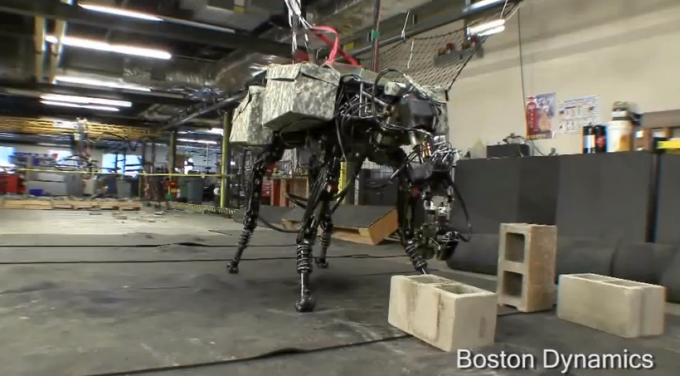อาจจะฟังดูไม่ตื่นเต้นเท่าไหร่ ถ้าบอกว่ามันเป็นการซื้อบริษัททั่วไปของ Google แต่ว่าถ้ารู้ว่ามันเป็นบริษัทหุ่นยนต์ที่ทำงานให้กับเพนตาก้อน และได้เห็นงานของบริษัทนี้แล้วอาจจะเปลี่ยนใจร้องโว้ววววว!! โดยบริษัทนี้มีชื่อว่า Boston Dynamics ก่อตั้งเมื่อ 1992 ทำงานค้นคว้าวิจัยให้กับ DARPA, เป็นที่ปรึกษาให้กับ Sony ในการสร้างเจ้าหุ่นยนต์ Aibo และนี่ก็เป็นบริษัทด้านหุ่นยนต์บริษัทที่ 8 ที่ Google ได้เข้าซื้อไปภายใน 6 เดือนที่ผ่านมา
ไปดูงานตัวอย่างของ Boston Dynamics กันซะหน่อยดีกว่า
ดูท่าว่าบริษัท Search ยักษ์ใหญ่นี้จะเอาจริงด้านหุ่นยนต์ ทุ่มแบบสุดตัวเอาเสียมากๆเลยนะเนี่ย ไม่แน่ว่า Google อาจจะเป็นบริษัทที่เป็น Cyberdyne บนโลกแแห่งความเป็นจริงก็ได้นะเนี่ย หะหะ ^^”
เทคโนโลยีหุ่นยนมันพัฒนาไปไกลกว่าที่คิดแล้วเหมือนกันนะ เพื่อนๆเห็นแล้วคิดว่าไงกันมั่งครับ
ถ้าใครมีประสบการณ์ด้านนี้มาเขียนแชร์ความรู้กันหน่อยนะ 🙂
source: NYtimes via Android Central

รอดูรุ่น Classic T800
ชื่อ android แต่ไม่มีหุ่นจริงๆออกมา ก็คงไม่สมชื่อ ^^
ถ้าได้นั่งบนหลังมันคงสนุกน่าดู
สมัยตอนเด็กๆ เห็นในหนังตอนนี้ก็มีให้เห็นกันแล้ว ถ้าเอาจริงผมว่าได้นะ เป็นกำลังใจครับ
ต้องภาวนา อย่าให้คนชั่วได้ ครองนะครับ ไม่งั้น อาจจะเป็นสิ่งเลวร้ายมากก็ได้ที่ได้เห็นหุ่นนักรบ
เบื่อเทคโนโลยีที่ จะเกิดๆๆ แต่สุดท้าย จะตายแล้วยังไม่ได้ใช้ โม้กันไปเรื่อยแล้วเราถืออะไรในมือ ก้อนสี่เหลี่ยมที่จะใช้แต่ละทีต้องคิดก่อนถ้าไม่ได้อยู่ใกล้ที่ชาร์จ เมื่อสิบปีก่อนก็มีก้อนนี้ แค่ไม่มีสี ถ้าบอกว่าไม่ได้เริ่มก็คงไม่มีวันได้ใช้ก็คงต้องขอบอกเลยว่า เบื่อรอ ทำออกมาขายเลยได้ป๊ะ ไม่ต้องยูสเซอร์เอกพีเลื้อนกันยาวหรอก hshahahaha
จัดหนักเลยแฮะช่วงนี้พี่เกิ้ล
google คิดครองโลก ^ ^
ผมกับเพื่อน ๆ ทำเว็บ http://www.thairobotics.com/ นำเสนอข่าวสาร บทความด้านหุ่นยนต์ครับ
มีเขียนถึงเรื่องนี้อยู่ด้วย วิเคราะห์เจาะลึกกรณี Google กว้านซื้อบริษัทหุ่นยนต์
แวะเวียนไปเยี่ยมชมได้นะครับ ^_^
ผมว่าน่าจะไปซื้อบริษัทที่ญี่ปุ่นจะช่วยได้เยอะเลย ?
แถมให้อีกอันครับ
Raytheon XOS 2 Exoskeleton, Second-Generation Robotics Suit, United States of America
OS 2 is a second-generation robotics suit being developed by Raytheon for the US Army. The company publicly demonstrated the capabilities of the exoskeleton for the first time at its research facility in Salt Lake City in Utah, in September 2010.
The wearable robotic suit increases the human strength, agility and endurance capabilities of the soldier inside it. The XOS 2 uses high-pressure hydraulics to allow the wearer to lift heavy objects at a ratio of 17:1 (actual weight to perceived weight). This allows repeated lifting of the load without exhaustion or injury.
Development as part of DARPA's exoskeleton programme
"The second generation XOS 2 robotic suit uses lighter material and is about 50% more energy efficient than the XOS 1."
The US Defense Advanced Research Projects Agency (DARPA) initiated development of the exoskeletons in 2001 under the Exoskeletons for Human Performance Augmentation programme. The agency funded $50m to various participants under the five-year programme. However, only two of them have been active in developing the exoskeleton prototypes for the US military.
The XOS system was originally developed as the Wearable Energetically Autonomous Robot (WEAR) by Sarcos Research of Salt Lake City, Utah. Development of the biomechanical robot was started in 2000. The company, established in 1983, was acquired by the defence contractor Raytheon in November 2007.
Sarcos is expected to have received about $15m in funds for the research and development of the WEAR, the initial proof-of-concept for the Raytheon's first exoskeleton prototype, XOS 1. It was unveiled in 2008. A fully operating tethered XOS version is expected to enter into military service by 2015. The untethered version is not expected to be operational until 2020.
The other exoskeleton is Lockheed Martin's Human Universal Load Carrier (HULC), initially developed as the Berkeley Lower Extremity Exoskeleton (BLEEX) by the University of California, Berkeley.
Features of Raytheon Sarcos's XOS 2 robotic suit
The second generation XOS 2 robotic suit uses lighter material and is about 50% more energy efficient than the XOS 1. The exoskeleton is expected to weigh about 95kg. It utilises a combination of controllers, sensors, high-strength aluminium and steel which allow structures and actuators to perform the tasks.
"The US Defense Advanced Research Projects Agency (DARPA) initiated development of the exoskeletons in 2001 under the Exoskeletons for Human Performance Augmentation programme."
Flexible hoses ease the fluid movement and allow smooth and efficient operations. The exoskeleton suit offers improved manoeuvrability and agility over the XOS 1 version. It is also more resistive to environmental challenges.
The Raytheon Sarcos robotic system can take on the weight of the payload on one foot through the powered limbs. The wearer can lift about 200lb of weight for long periods of time without feeling the strain.
The soldier wearing the suit can walk, run and can readjust to keep the load off the wearer, even upon stumbling. The exoskeleton is robust and allows punching through three inches of wood. It is also highly agile and does not bog down the wearer while climbing stairs, ramps, using a punching bag or kicking a football.
The company is currently focussing on the logistics support variant. Continuous lifting of heavier objects by the military soldiers can lead to orthopaedic and other injuries. On average, the logistic and support military personnel are estimated to lift about 16,000lb of load a day. The robotic suit will ease the logistics problems faced both in the theatre and off the field.
The soldier wearing the XOS 2 exoskeleton can perform the work done by up to three soldiers. It will, therefore, ease the challenges and reduce the costs and manpower requirements. The suit is also expected to be used for more strategic missions. Raytheon Sarcos also plans to develop several variations, based on the customer requirements and mission possibilities.
Operational capabilities of the second-generation exoskeleton
The XOS 2 system is powered by an internal combustion hydraulics engine with electrical systems. The prototype is tethered to the hydraulics power source by a wire. The engine drives the hydraulic actuations. The various sensors equipped throughout the system specify the position and the force required.
Computer processors are situated at every joint of the suit. Sensors send signals to the processors through ethernet. This further prompts the actuators to deliver about 200kg of force per square centimetre using pressurised hydraulics. It enables the soldier to lift 50lb with each arm.
Raytheon Sarcos is planning to develop a fuel-carrying backpack with custom hydraulic servos for providing endurance of about eight hours. It will allow mobility and gait of the robot in combat environments. Use of hydraulics as the power source, instead of lithium ion batteries, eliminates the risks of breach and explosion.